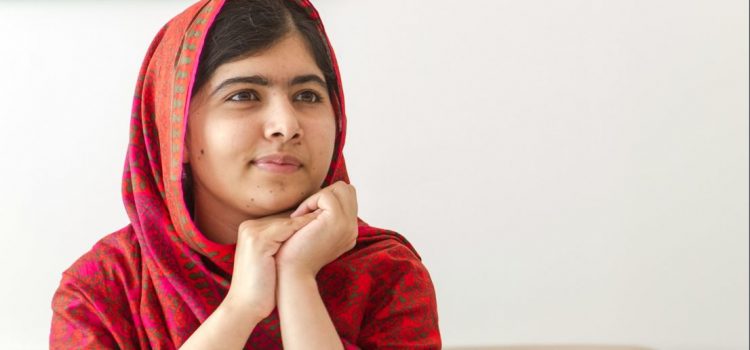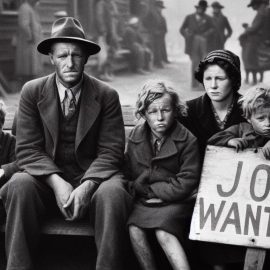
Why does Malala Yousafzai have such a strong value for education? How does she find the courage to speak out against people who want her dead?
It’s a remarkable story: A child born into poverty in a society that valued boys over girls and religious tradition over secular education became a Nobel-winning activist for girls’ education. Malala Yousafzai’s activism started at an early age and continues to inspire people all over the world.
Continue reading to learn how even a bullet couldn’t stop Malala’s brave fight against evil.
The Roots of Malala Yousafzai’s Activism
Malala Yousafzai’s activism has its roots in a strong, outspoken family with a high value for education. When Malala was young, her family was very poor. They lived in a two-room shack opposite the school her father, Ziauddin, had cofounded. Malala’s family also valued generosity and compassion toward the less fortunate. For example, Ziauddin let poor children enroll in his school free of charge. When the school eventually grew to 800 students, 100 of them were attending tuition-free.
Like her parents, Malala was motivated by compassion for the poor. There was a huge trash heap down the street from her house because there was no garbage collection in Swat. When she saw some children there, collecting recyclable waste to sell, Malala begged her father to give the children free places at his school. He started a local campaign arguing for the education of these poor children.
Gender Roles in Malala’s Family and Pashtun Society
Malala’s family were traditional Pashtun Muslims in many ways, but, when it came to gender roles, they frequently defied tradition. For Pashtuns, the birth of a girl is considered a disappointment, as they believe that women’s sole function is to prepare food and give birth. But, when Malala was born, her father believed there was something unique about her.
Malala was proud to be Pashtun, but she didn’t agree with some aspects of the Pashtun code of behavior, or Pashtunwali, especially in regard to women. She knew that, as soon as she got a little older she wouldn’t be so free. Pashtun women and older girls were expected to stay inside, cooking for and serving the men and boys in the family. Women and girls weren’t allowed to leave the home without a male relative. Malala’s mother and aunts had not been allowed to attend school; Malala’s mother, Toor Pekai, couldn’t read or write. However, as Malala got older, her parents supported her not only in continuing her education but also in speaking out publicly against the Taliban.
Malala’s family often went to stay with her father’s family in the mountain village where he grew up. There, women couldn’t leave the house without covering their faces, and they weren’t allowed to speak with men unless they were close relatives. Malala didn’t cover her face in the village, even when she became a teenager. The people in the village criticized her, but her father defended her.
The Value of Education in Malala’s Family
Malala’s family had a long tradition of valuing secular education. Her grandfather taught theology in a government high school. He sent Ziauddin to the government school rather than the religious madrasa.
Malala’s father attended a good university, and he founded a school. Over time, the school grew and expanded to three locations. Ziauddin became known in the community for his willingness to speak up and criticize the government and the army.
Malala grew up in her father’s school, sitting in on classes and admiring the teachers. When she started attending school herself, she loved it.
| Religious and Secular Education in Pakistan As Malala notes, there are two systems of education in Pakistan: Islamic religious education at madrasas, and secular education at either government-run or private schools. The tradition of madrasas dates back almost a thousand years. Historically, their purpose was not to educate the general population but to train future religious scholars and clerics. Until the 1980s, there were only a few hundred madrasas in Pakistan. However, in 1977, General Zia came to power and began a campaign of “Islamization” that included opening thousands of madrasas throughout the 1980s. By 2001, there were approximately 45,000 madrasas in Pakistan. These schools became popular in part because Pakistan’s secular public education system was so poor. For years, Pakistan has spent only 2-3% of its gross national output on public education—one of the lowest rates in the world. Government-run schools frequently lack teachers, books, and electricity and are plagued by corruption. In the 1980s and 1990s (and continuing to today), families who could not afford to send their sons to private schools sent them to madrasas, which provided free room and board. Unlike their predecessors, some schools in this new generation of madrasas taught a violent version of Islam, which preached war, suicide attacks, and the killing of innocent civilians in the name of religion. These madrasas were both a training ground and a recruitment pool for terrorist groups, including the Taliban and al-Qaeda. While most madrasas are not affiliated with radical militant groups, they nonetheless fail to teach the basics of secular education needed in the modern job market, leading to high rates of unemployment and creating a roadblock to Pakistan’s economic development. |
Precursors to the Taliban in the Swat Valley
In 2002, the MMA Alliance won the elections in Malala’s province. They tore down billboards featuring pictures of women or covered the images with black paint. They took female mannequins from clothing shops and insisted women wear head coverings.
Malala’s father opened his high school in 2003; at the time, boys and girls were in the same classes. But, by the following year, the atmosphere in the province had changed so much that having co-ed classes was no longer an option.
In 2005, a massive 7.6 earthquake hit Pakistan, killing over 73,000 people. The Movement for the Enforcement of Islamic Law, or TNSM—a group that had sent men to fight alongside the Taliban in Afghanistan and was now led by Maulana Fazlullah—provided some aid to remote villages that the government hadn’t been able to help.
Taking advantage of the atmosphere of fear created by the earthquake, mullahs (religious leaders) from the TNSM preached that the earthquake was a punishment from God for women’s freedoms and obscenity. The mullahs warned that, if people did not adopt sharia, or Islamic law, God would send more severe punishments.
The Taliban’s Imposition of Increasingly Harsh Sharia Law in the Swat Valley
Malala was 10 when the Taliban came to the Swat Valley. Their leader was 28-year-old Fazlullah. He set up a radio station in the Swat Valley known as Mullah FM, and people called him the Radio Mullah. Many people in Swat got all of their information from the radio because they didn’t have a TV or were illiterate.
Soon, says Malala, the Radio Mullah began telling people to stop listening to music, watching movies, and dancing—activities that he said were sinful and had caused the earthquake. Fazlullah often preached directly to women, instructing them to stay home and go outside only in emergencies. Malala was confused by this because she knew that the Quran did not say that women should stay home and only men could go out.
Soon, the Radio Mullah was preaching that girls should not go to school. On his radio program, he named girls who had quit school and congratulated them, saying they’d go to heaven. He also told women not to go shopping at the bazaar. If they did try to go, the Taliban would shout at and intimidate them until they went home.
One day, when Malala and her family were passing through a Taliban checkpoint, Taliban soldiers carrying Kalashnikovs told Malala and her mother that their failure to wear Burqas was shameful. When the family returned home, they found a note from the Taliban on the gates of Ziauddin’s school. It threatened severe punishment unless the school stopped teaching girls.
Besides fighting government forces, the Taliban also acted as morality police, targeting women who weren’t observing purdah. Benazir Bhutto gave a speech in which she condemned the militants. Immediately after the speech, she was assassinated. Many Pakistanis, including Malala, felt that their hope for democracy and women’s rights in the country died along with her.
Malala Campaigned for Girls’ Education and Against the Taliban
Surrounded by the Taliban’s increasing violence and attacks on women and girls, Malala did what she believed was right. She continued going to school despite the Taliban’s prohibition on girls’ education. She hid her book bag on the way there and back and didn’t wear her uniform to avoid detection by the Taliban.
The fighting continued in the Swat Valley in 2007 and 2008. Fazlullah started blowing up schools, usually after the night curfew when no one was in them. There were school bombings almost every day. One of them killed 10 members of Malala’s best friend’s family. By the end of 2008, the Taliban had destroyed over 400 schools.
Some of the Pashtun elders in Swat, including Ziauddin, banded together to challenge Fazlullah. They spoke out against the Taliban by giving interviews on radio programs like Voice of America and the BBC. Malala’s father encouraged her to speak up, and she began giving interviews as well.
She started when she was 11 by doing group interviews with her classmates, in which they spoke about girls dropping out of school because of the Taliban. But, when her classmates reached 13 and 14, the men in their families didn’t want them to give interviews anymore because they were afraid the Taliban would punish them for not observing purdah after puberty. Malala had the support of her father and believed it was important to speak the truth, so she continued. She believed God would protect her because she was doing what was right.
Ziauddin’s friend, a BBC radio correspondent, called him looking for a female teacher or student to write a weekly diary about life under the Taliban. Malala volunteered to do it. They had a computer, but there were frequent power cuts and little internet access, so the correspondent interviewed Malala over the phone and wrote up her thoughts. She used a pseudonym—Gul Makai—and couldn’t tell anyone she was writing the diary because it was too dangerous. The diary garnered international attention. Malala began to see the power of the written word.
(Shortform note: While Malala’s diary gained international attention, at home she received a lot of backlash with people calling her a “drama queen,” accusing her of blasphemy, and even saying she was a CIA agent. But Pashtun girls changed their opinion of her once they read her diary—many were inspired to write their own diaries and became more eager to go to school.)
At the end of 2008, the Taliban announced that all girls’ schools must shut down by January 15. On the day Malala’s school shut down, she and her classmates stayed late playing, and then she went home and cried. After that, she did as many TV and radio interviews as she could. She said that the Taliban could close the schools, but they couldn’t stop girls from learning. However, she feared it would be very hard to learn, much less get a job, without school.
After the Taliban banned girls’ education, Pakistanis spoke out in a way they hadn’t before. The Taliban agreed to lift the ban for girls up to 10 years old. Malala was 11, but she and others her age pretended they were younger so they could start going to school again.
| The Fight for Gender Equity in Education Worldwide The serious obstacles Malala faced in attempting to get an education under the Taliban are in many ways representative of what girls all over the world experience. And like Malala, many individuals and organizations are fighting for gender equity in education worldwide. Although education is a human right, 129 million girls are out of school worldwide and only 49% of countries have achieved gender parity in education. In the bottom 10 countries for girls’ education—countries like Pakistan and Nigeria—the vast majority of girls do not attend any type of secondary school, meaning that their education ends at age 11. In Afghanistan, where the Taliban returned to power in 2021 two decades after being overthrown by the US, girls are completely banned from attending school after the sixth grade. Like Malala, many girls face threats to their education due to armed conflict and gender bias resulting from cultural or religious norms. Other common barriers to girls’ education include poverty, child marriage, and gender-based violence. While boys face some of these obstacles as well, families with fewer resources often favor boys when investing in education. Although the reasons girls are unable to attend school vary by country and community, research demonstrates that the benefits of girls’ education are universal. Girls’ education improves economies and creates more stable societies. Women who receive a primary and secondary education are more likely to be employed, make more money, and provide better nutrition and health care for their families. They’re less likely to experience discrimination, gender-based violence, and child marriage. Because the need for gender equity in education is great and the benefits to society are significant, many organizations are working globally to advance girls’ education, from Camfed in Africa to Girls Who Code in the US to Malala’s own nonprofit, the Malala Fund, founded after her shooting. These nonprofits advocate for policy change, provide teacher training and student mentoring, and work to remove the barriers to girls’ education. |
Malala’s Family Fled the Swat Valley
Finally, the Pakistani Army launched a more intensive effort to drive the Taliban out of Swat. Amidst the fighting, Malala’s family left the Swat Valley along with almost two million Internally Displaced Persons (IDPs).
Malala and her family were away from their home for about three months. When they returned, they found buildings in ruins, piles of wreckage, and walls covered with bullet holes. Life began to regain a semblance of normalcy. But, just when people started to think the Taliban was really gone, there was a series of bombings, kidnappings, and murders. Ziauddin continued to speak out against the Taliban, and he received another death threat.
Malala’s Profile Continued to Rise
Meanwhile, Malala received many awards for speaking out for girls’ education, and she continued to give interviews to TV and print journalists. During one speech at a gala, she spoke publicly for the first time about defying the Taliban’s orders and going to school in secret.
Malala’s rising profile attracted attention, and she received a death threat from the Taliban. Although her parents were worried and encouraged her to pause her work, Malala wanted to keep speaking out. She reassured herself with the thought that the Taliban had never targeted a young girl. She was more worried about her father than herself.
Nonetheless, Malala started having nightmares about the Taliban shooting her or throwing acid in her face. At night after everyone was asleep she double-checked that every door and window in the house was locked and prayed that her family and all of Swat would be protected from the Taliban.
Malala Was Shot by the Taliban
By the time Malala was 15, she had been speaking out against the Taliban, at increasingly greater personal risk, for four years. She and her family had been receiving threats from the Taliban for a year.
On October 9, 2012, Malala was riding the bus home from school with 19 other girls when Taliban soldiers pulled them over. A man asked for her by name, then shot her in the face point-blank. The bullet went through her left eye socket, exited her head, and lodged in her shoulder, narrowly missing her brain. She survived. The Taliban later claimed responsibility for shooting Malala. They said they had done it, not because of her fight for girls’ education, but because she supported Western, secular ideas.
Malala Continued Her Fight for Girls’ Education From Her New Home in England
The Pakistani government rented an apartment in Birmingham for Malala’s family to stay in while she recovered. Six months after the attack, Malala was well enough to start school in Birmingham. She couldn’t return to Pakistan because it was still dangerous for girls to get an education.
On Malala’s 16th birthday, she gave a speech about girls’ education at the UN in New York. She wrote the speech not just for the UN delegates, but for people all over the world whom she hoped to inspire.
She also founded the Malala Fund, which works to ensure that girls around the world receive an education. She went to Kenya to build a school and to Nigeria to show solidarity with schoolgirls abducted by militants. She went to the White House to discuss girls’ education with US President Barack Obama. She told the president that instead of trying to root out terrorism through war, the US should work to eliminate terrorism through education.
Exercise: Learn From Malala’s Example
Malala fought for what she believed in despite great risk. But, standing up for your beliefs isn’t always a matter of life and death. Consider how you can learn from Malala’s example to stand up for your own beliefs and values.
- Malala’s love of learning and her belief that the Taliban’s ban on girls’ education was unjust inspired her to speak out. Is there anything in your life that you feel is unjust and want to change? List the issues or causes that are close to your heart.
- Malala fought for her beliefs by doing things like publishing a blog of her life under the Taliban, appearing in a documentary, giving interviews and speeches—and living her normal life as a student even in the face of the Taliban’s ban on girls’ education. What actions can you take in your life to advance a cause you care about?






